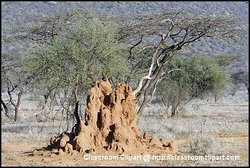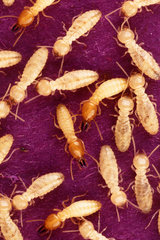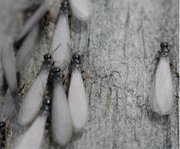Termite
|
|
| Termites | ||||||||||||
|---|---|---|---|---|---|---|---|---|---|---|---|---|
| Scientific classification | ||||||||||||
| ||||||||||||
| Families | ||||||||||||
|
Mastotermitidae | ||||||||||||
| Binomial name | ||||||||||||
| Earthlife Earthlife (http://www.earthlife.net/insects/isoptera.html), 2002-07-26 |
A termite (also known as a white ant) is any member of the order Isoptera, a group of social insects that eat wood and other cellulose -rich vegetable matter. Most termite species are tropical or subtropical, but a few live in temperate regions. They are of great biological and economic interest.
Termites have biting mouthparts and are soft-bodied, of moderate to small size. They live in dark nests and tunnels, except when the winged alates emerge to leave their parent colony. The bodies of flying individuals are dark, but termites which remain in the nest are whitish with only their heads being heavily pigmented. The temporary wings of termites are long and slender, in two pairs that are similar to each other. The veins near the anterior margin of the wing are strong and the rest are faintly marked. The wings are shed after the swarming termites find a new nest site.
Termites do not physically resemble ants; their "white ant" name is probably due to their similar social habits. The termite colony contains workers, soldiers, and reproductive individuals of both sexes. The workers are developed in subordinate castes in several species. The soldiers have large heads and strong jaws, and in some species are highly specialized. Many have jaws so overdeveloped that they cannot feed themselves without the assistance of workers, and varieties are known that squirt noxious turpentine-like liquid through a horn-like nozzle. In some colonies, the queen becomes enormous and quite helpless through the expansion of her abdomen as eggs develop. The workers feed and groom her and carry away her eggs to nursery chambers. Termites undergo incomplete metamorphosis, with their freshly hatched young taking the form of small termites that grow without significant morphological changes.

Termites cannot themselves digest the wood that they consume. Instead they rely upon symbiotic protozoans (metamonads) in their intestines to digest the cellulose for them, absorbing the end products for their own use. These protozoans in turn rely on symbiotic bacteria to produce the necessary enzymes. This relationship is one of the finest examples of mutualism among animals.
Because of their wood-eating habits, termites sometimes do great damage to buildings. Their habit of building tunnels wherever they go and of remaining concealed within the wood where they work often results in their presence being unknown until the timbers, riddled with tunnels until spongelike inside, give way. Once they have entered a building they do not limit themselves just to wood, also damaging paper, cloth, carpets, and other materials. In regions where termites are plentiful, no timber in construction should be left in contact with the ground. Exposed timber can be made resistant to attack by impregnation with creosote or other chemicals, but the most effective defense is a masonry foundation. Even so, termites are able to build tunnels with walls of packed earth over several feet of masonry or work through small cracks to reach wooden parts of a building. When termites have already penetrated a building, removing their means of access and destroying the colony with fumigation are usually effective means of stopping further damage. Another common method of treating termites in houses in Australia is the use of arsenic trioxide powder. This is carried back to the nest by the workers, killing the queen, and thus the nest.
In some regions, notably arid tropical savannas, termites construct extremely large and elaborate mounds to house their colonies. These termite mounds can have very distinctive forms, such as the compass termite which build tall wedge-shaped mounds with the long axis oriented north-south for maximum solar heating, and are as hard as concrete. Some mounds can reach heights of 20 feet (6 m) or more. The internal structure of these mounds can be quite complex, with ventilation chimneys for active temperature control, nursery and waste-disposal chambers, and a well-defended internal fortification containing the queen.Clipart and Animal Pictures
- Clipart (https://classroomclipart.com/image/category/clipart.htm)
- Animal Clipart (https://classroomclipart.com/image/category/animal-clipart.htm)
- Animal Animated Clipart (https://classroomclipart.com/clipart/Animations/Animals.htm)
- Pictures of Animals (https://classroomclipart.com/image/category/animal-photos.htm)
- Amphibian Clip Art, Pictures and Photogaphs (https://classroomclipart.com/image/category/amphibian-clipart.htm)
- Farm Animal Clip Art, Pictures and Photographs (https://classroomclipart.com/image/category/farm-animal-clipart.htm)
- Mammal Clip Art, Pictures and Photographs (https://classroomclipart.com/image/category/mammal-clipart.htm)
- Marine Animal Clip Art, Pictures and Photographs (https://classroomclipart.com/image/category/marine-life-clipart.htm)
- Reptile Clip Art, Pictures and Photographs (https://classroomclipart.com/image/category/reptile-clipart.htm)
- Spider Clip Art, Pictures and Photographs (https://classroomclipart.com/image/category/spider-clipart.htm)
- Pictures of Termites (http://classroomclipart.com/cgi-bin/kids/imageFolio.cgi?direct=Animals/Insects/Termites)
- Pictures of Insects (http://classroomclipart.com/cgi-bin/kids/imageFolio.cgi?direct=Animals/Insects)



